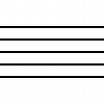Musical Note Trivia: Identify These Symbols! Quiz
(107).jpg)
How good are you when it comes to music? There are different ways that you can perfect your knowledge, and this musical note trivia is perfect for you. How about you give it a shot and see if you can identify these symbols correctly. Do give it a shot and keep an eye out for more quizzes like it to perfect for you.
- 1.
A QUARTER NOTE RECEIVES HOW MANY BEATS?
- A.
2
- B.
3
- C.
1
- D.
4
Correct Answer
C. 1Explanation
A quarter note receives one beat in music notation. In a musical time signature, the quarter note is typically given the value of one beat, making it the basic unit of measurement for the duration of notes in a piece of music.Rate this question:
-
- 2.
A HALF NOTE RECEIVES HOW MANY BEATS?
- A.
2
- B.
4
- C.
6
- D.
1
Correct Answer
A. 2Explanation
A half note receives two beats in music. In musical notation, a half note is represented by an open oval shape with a stem. It is held for twice the duration of a quarter note and half the duration of a whole note. In a 4/4 time signature, which is the most common time signature, a half note would be held for two beats. This means that it would be played or sung for the duration of two counts or pulses in the music.Rate this question:
-
- 3.
A WHOLE NOTE RECEIVES HOW MANY BEATS?
- A.
2
- B.
4
- C.
6
- D.
8
Correct Answer
B. 4Explanation
A whole note receives 4 beats because in music notation, a whole note is represented by an open circle and it is the longest note value. In most time signatures, a whole note is equivalent to 4 beats. This means that it is held for the duration of 4 beats in a measure.Rate this question:
-
- 4.
PIANISSIMO (PP)=?
- A.
LOUD
- B.
VERY LOUD
- C.
SOFT
- D.
VERY SOFT
Correct Answer
D. VERY SOFTExplanation
The term "pianissimo" is a musical term that indicates a very soft volume. It is often abbreviated as "PP" in sheet music. Therefore, the correct answer is "VERY SOFT."Rate this question:
-
- 5.
FORTISSIMO (FF) =?
- A.
LOUD
- B.
VERY LOUD
- C.
MEDIUM LOUD
- D.
MEDIUM SOFT
Correct Answer
B. VERY LOUDExplanation
The term "fortissimo" is a musical term used to indicate a very loud volume. It is derived from the Italian word "forte," meaning loud, and the suffix "-issimo," which intensifies the meaning. Therefore, the correct answer is "LOUD, VERY LOUD" as it accurately represents the meaning of "fortissimo."Rate this question:
-
- 6.
PIANO (P) =?
- A.
REALLY LOUD
- B.
SOFT
- C.
REALLY SOFT
- D.
LOUD
Correct Answer
B. SOFTExplanation
The correct answer is "SOFT" because the word "PIANO" is associated with soft music. A piano is a musical instrument that can produce both soft and loud sounds, but it is commonly known for its ability to create soft and delicate tones.Rate this question:
-
- 7.
- A.
THIS IS A TEMPO
- B.
THIS IS A STAFF
- C.
THIS IS A TREBLE CLEF
- D.
THIS IS A CANDY BAR
Correct Answer
C. THIS IS A TREBLE CLEF -
- 8.
- A.
THIS IS A STAFF
- B.
THIS IS A CLEF
- C.
THIS IS A MAP
- D.
THIS IS A KEY
Correct Answer
A. THIS IS A STAFF -
- 9.
- A.
THIS IS A STAFF
- B.
THIS IS A CLEF
- C.
MEASURE
- D.
THIS IS A BARLINE
Correct Answer
C. MEASURE -
- 10.
HOW MANY LINES MAKE UP THE STAFF?
- A.
6
- B.
3
- C.
4
- D.
5
Correct Answer
D. 5Explanation
The staff typically consists of five lines, which are used to represent musical notes. Each line represents a different pitch, allowing musicians to read and interpret sheet music accurately. Therefore, the correct answer is 5.Rate this question:
-
- 11.
__
- A.
THE ARROW IS POINTING TO THE MEASURE
- B.
THE ARROW IS POINTING TO THE NOTE
- C.
THE ARROW IS POINTING TO THE CLEF
- D.
THE ARROW IS POINTING TO THE BARLINE
Correct Answer
D. THE ARROW IS POINTING TO THE BARLINEExplanation
The arrow is pointing to the barline. The barline is a vertical line that separates measures in musical notation. It is used to indicate the organization of the music into smaller sections or measures.Rate this question:
-
- 12.
DRAW A QUARTER NOTE REST.
Correct Answer
SYMBOL - 13.
DRAW A HALF NOTE REST.
Correct Answer
SYMBOL - 14.
DRAW A WHOLE NOTE REST.
Correct Answer
SYMBOL - 15.
FORTE (F) = ?
- A.
SOFT
- B.
LOUD
- C.
VERY SOFT
- D.
VERY LOUD
Correct Answer
B. LOUDExplanation
The word "FORTE" is a musical term that means "loud" or "strong." In this context, "LOUD" is the correct answer because it is the opposite of "SOFT" and represents the opposite end of the volume spectrum. "VERY SOFT" and "VERY LOUD" are not the correct answers because they are not the direct antonyms of "FORTE."Rate this question:
-
Quiz Review Timeline +
Our quizzes are rigorously reviewed, monitored and continuously updated by our expert board to maintain accuracy, relevance, and timeliness.
-
Current Version
-
Feb 14, 2024Quiz Edited by
ProProfs Editorial Team -
Jan 16, 2012Quiz Created by
Razorsax86
 Back to top
Back to top




